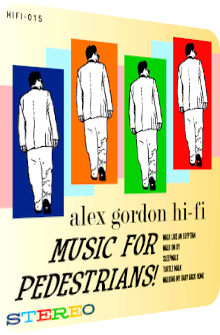
Alex Gordon Hi-Fi
Music For Pedestrians!
2013
Music For Pedestrians! is a concept EP by the Atlanta-based artist Alex Gordon whose project Alex Gordon Hi-Fi comprises of only one musician and one single instrument: himself on the baritonic guitar. It is released in March 2013 and available to purchase and listen to in full at Bandcamp. In the colorful realms of Exotica with its magnanimous textures, string washes and percussion schemes, the prospect looks admittedly grim and overly archaic. How can one single non-electronic instrument possibly be suitable nowadays? Does Alex Gordon mimic the concept of a medieval lutanist? Thankfully not! Naturally, the baritonic guitar cannot replace a fully fleshed out orchestra, but Gordon knows how to treat the strings of this seemingly commonplace instrument, letting it emanate vivacious cavalcades of colors, various tonal ranges and multitudinous attack rates.
His signature instrument can only be as good as the material it sets to music, and it is here where Music For Pedestrians! shines. Each of the five included tracks features a different kind of walk and is usually well-known and familiar to genre aficionados. Some of the included tunes seem questionable in an Exotica context, but rest assured that Alex Gordon knows how to polish their melodies. Even bubble gum Pop anthems suddenly unveil a new complexion. The appeal of the EP not only manifests itself in the aural mutations of the compositions, but also right from the get-go via its concept: as obvious and potentially lame a collection of pedestrian-related tunes is, it has not been done before, at least not in the realms of quasi-Exotica and Easy Listening. And in my opinion at least, the EP tops the flood of lackluster compilations of songs about love or cruising in one’s car by a wide margin. Here is a closer look at Alex Gordon Hi-Fi and Music For Pedestrians! – walkers of all nations, unite!
It is 1986 when The Bangles deliver their smash hit Walk Like An Egyptian, written by Liam Sternberg and David Kahne. Devoted Exotica luminaries might certainly stick their noses up, but in-between the synthetic bubble gum Pop structures, glints of tropical verdure flash beyond the drum computer and guitar effulgence, namely in the shapes of Chinese gongs and Latinized percussion. Alex Gordon strips off the glam grandiloquence of the original, empties the medulla out of its bone structures and leaves an impression wadded in thick bass runlets. His baritonic guitar delivers an abysmally deep base frame whose fissured structure allows sustain and reverberation to be catapulted into the distance for microseconds. The bassline is already a feast, so simple, yet funky and warped.
The famous lead melody resides in higher tone spectrums and appears decidedly thinner than the ubiquitous bass blebs. This allows for an eminently exciting twist that may be essential in the world of music, but remains enchanting whenever it is dropped in a song: the polyphony of the chords. Large portions of the melody only comprise one slapped string at a time, but whenever the spiraling or isolated moist chords occur, the ensuing sun-fueled warmth is incredible. Marrying the streamlined Pop production with the sleaziness of a Surf tune, the result is a successful transformation where minimalism and reduction are the keys to understanding the edge of the original, whether one likes it or not.
Burt Bacharach’s and Hal David’s Walk On By is next and lacks the novelty factor, but this is not Alex Gordon’s fault; this tune has simply been covered and interpreted a gazillion times in all shapes and forms, so the competition is much larger. Envisioned and recorded at the end of 1963, the string-heavy pre-Disco flavor obviously has to be neglected by Atlanta's guitar expert, but the Jamaicanized flavor of the melody by means of the baritonic guitar boosts the impression of a sunburst scenery. The slapped strings sound fresh and crisp, the backing undulation almost aquatic and turquoise, and if there was some sort of careful percussion added to this rendition, it would have been even dreamier.
The following take, however, is a masterpiece and partially listable in the hall of fame of Exotica: Santo & Johnny’s Sleep Walk. The Farina Brothers’ corker from 1959 is already heavy on the steel guitar side, and so the transmutational effect of Alex Gordon’s guitar feels less than an endemic gimmick rather than a faithful and cautious bow to the original. The tempo is revved up slightly, a darker strumming finds its way to the otherwise glistening-coruscating insouciance of the presentation, and it is a fitting injection, for it is apparent in Santo & Johnny’s blueprint already. A short fleeting visit to Space-Age dimensions is delivered near the end when the elasticized oscillation of the guitar wobbles along, encapsulated in enigma and mystique.
Turtle Walk by jazz saxophonist Lou Donaldson is the fourth installment in Alex Gordon’s training guide for pedestrians. Released in 1969 as part of Donaldson’s Hot Dog album, its original runtime of almost eight minutes is mercilessly abridged and dissected here and turns out to be the shortest rendition with a runtime of 100 seconds. This is yet again no cause for alarm. The eclectic protuberances and labyrinthine interdependencies of the original are recorded by a quartet, melodies fly by and twirl in the distance only to face the daylight at a later stage. In this regard, Alex Gordon does something quasi-magical and carves out the most euphonious bits of this wonky classic. Right from the get-go, the monotonous shrapnel of the bass splinters captures the city-strolling prowl of the original, the change between glitzy chords and murkier counterpoints simulates the interplay of Donaldson’s band, but this aural visualization remains opaque to those who do not know the original. Due to the convoluted physiognomy of Hot Dog, a guitar arrangement cannot possibly draw from the same wealth of energy, syncopation and layering techniques, the good-spirited craziness does not fit well in these meager-barren surroundings. One interesting note remains that justifies Gordon’s effort though: the augmentation of shadiness. Hot Dog sounds slick and sneaky, true, but the omnipresence of darker billows and bass accents make it a curious critter.
The finale of Music For Pedestrians! leads the listener to 1930: Fred Emil Ahlert’s and Roy Turk’s Walkin' My Baby Back Home has also been considered thousands of times by various artists. Alex Gordon’s take is covered in thermal heat and might well be the warmest song of this EP. Many chords and overlaid riffs expand the aura of carefreeness and paradise, making a beach ballad out of a big band hit that never was to be linked to the Copa Cabana or a tropical destination of your choice. Here, at last, the guitarist’s overhauled reconstruction procession works out flawlessly and adds much to the spirit of the composition… via cutback!
The idea is so obvious in hindsight, the arrangements so utterly minimal, the melodies thankfully so strong that Music For Pedestrians! is a delight and the proverbial nice change. Granted, Alex Gordon has only so many possibilities with a baritonic guitar in front of a backdrop of nothingness, but he makes the most of the designedly forsaken atmosphere in regard to the textures. The slapped strings feel dark, wooden, moist, abyssal and crystalline, depending on the respective material and impulsiveness. Since the minimalism can grow tiresome, Gordon makes two incredibly important and right decisions that make Music For Pedestrians! the one-of-a-kind EP it is. Firstly, the form of the medium itself is rightly chosen. One or two additional tunes would have probably been a bit too much for this five-track EP. Since the Atlantan also concocts full album-length packages with as much as a whopping 15 tracks, that ancient wisdom called “less is more” works to the EP’s advantage. And secondly, the concept is incredibly unique and tightly set.
Not all of these tracks are exotic per se, sure, but the realization and transformation exotifies them nevertheless, even strongly so. That this is achieved without the use of percussion, let alone a second musician who would make a Hapa Haole-like setup possible, is a strongly convincing characteristic trait. I am still of the opinion that Alex Gordon’s undeniable talent on the baritonic guitar is of better use in a funky ensemble, but also have to admit that his devotion and craftsmanship works flawlessly in isolated form as well. Music For Pedestrians! is a special little artifact with the exact right duration and choice of material.
Further listening and reading:
- You can purchase and listen to the EP in full at Bandcamp.
- Alex Gordon’s homepage is alexgordonhifi.com.
Exotica Review 245: Alex Gordon Hi-Fi – Music For Pedestrians (2013). Originally published on Aug. 3, 2013 at AmbientExotica.com.
